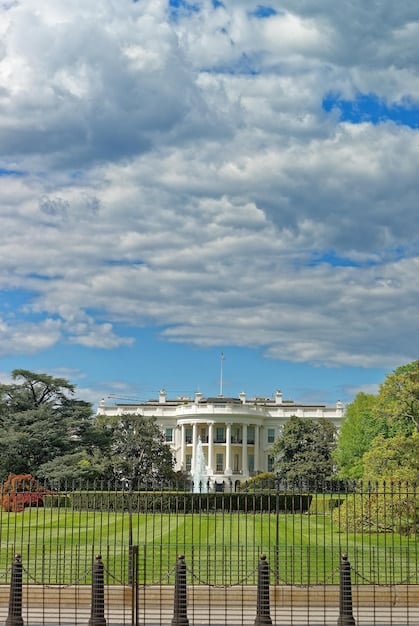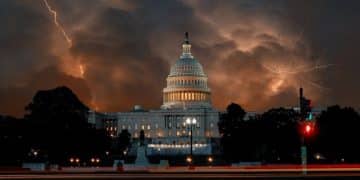Breaking: Supreme Court’s Immigration Ruling – Impact & Implications

Breaking: Supreme Court Ruling on Immigration Policy – Immediate Impact and Future Implications refers to the legal challenges, arguments, and potential outcomes following a significant decision by the Supreme Court regarding immigration laws, impacting individuals, families, and government policies.
The nation turns its attention to the Supreme Court as a pivotal decision concerning immigration policy unfolds, with Breaking: Supreme Court Ruling on Immigration Policy – Immediate Impact and Future Implications set to reshape lives, challenge legal norms, and ignite debates across the United States.
Breaking down the Supreme Court’s immigration policy ruling
The Supreme Court’s decisions hold immense power, shaping the legal landscape and impacting millions. A recent ruling on immigration policy has sent ripples across the nation, prompting questions about its immediate effects and long-term consequences. Understanding the nuances of this ruling is crucial for anyone concerned with immigration, law, and social justice.

Key aspects of the Supreme Court’s Decision
This ruling addresses several key areas within immigration law, potentially altering enforcement protocols, eligibility criteria for certain immigration benefits, and the balance of power between federal and state immigration authorities. Several factors influenced the court’s deliberations, ranging from constitutional interpretations to considerations of national security and humanitarian concerns.
- Constitutional Interpretation: The Court’s interpretation of constitutional provisions has often formed the bedrock of its decisions.
- National Security: Concerns about national security often weigh significantly in immigration-related cases.
- Humanitarian Concerns: The Court must also consider the humanitarian implications of its decisions, especially concerning vulnerable populations.
The actual text of the ruling can be complex, but breaking it down into understandable components makes it easier to grasp its implications. The core arguments, the prevailing opinions, and any dissenting views offer a comprehensive picture of the Court’s stance.
Immediate impacts on individuals and families
A Supreme Court ruling on immigration policy creates immediate ripples, directly impacting individuals and families. The effects can range from altered visa processes to potential deportation risks, creating palpable anxiety and uncertainty within immigrant communities.
Visa processing changes
Visa processing is a crucial aspect of immigration, and the ruling could lead to significant changes. These may include stricter eligibility requirements or altered application procedures, affecting those seeking to enter or remain in the country legally.

Potential Deportation Risks
One of the most immediate anxieties revolves around the potential for increased deportations. Depending on the specifics of the ruling, certain groups may face a higher risk of being deported. Individuals, families, and communities often experience emotional chaos during such processes.
- Increased Enforcement: Enforcement agencies might ramp up operations based on the new guidelines.
- Resource Allocation: Resources could be redirected to focus on specific categories of individuals now deemed priorities for deportation.
- Community Impacts: Communities with large immigrant populations could undergo considerable stress and disruption.
Understanding these immediate impacts is crucial for those directly affected, as well as for advocates, legal professionals, and policymakers responding to the changing landscape.
Future implications for immigration policy
Beyond the immediate fallout, the Supreme Court’s ruling lays down the groundwork for future immigration policy, reshaping how the legislative and executive branches navigate this complex field. The ruling may either reinforce existing policy trajectories or initiate entirely new ones.
Legislative response to the ruling
The legislative branch can react to the Supreme Court’s decision in various ways, from drafting new laws to amending existing ones. Lawmakers might aim to codify, expand, or counteract aspects of the ruling depending on their political objectives.
Impact on executive actions
The executive branch, responsible for implementing immigration laws, will need to adapt its strategies and protocols. This can manifest in policy changes, enforcement priorities, and modifications to existing programs. Over time, these actions can set new precedents that shape successive administrations’ approaches.
- Policy Adjustments: Agencies may need to revise internal policies to align with the Court’s interpretation.
- Enforcement Prioritization: Enforcement strategies may be recalibrated to focus on different categories of immigrants.
- Program Modifications: Existing programs may be altered or new ones launched to address the ruling’s effects.
Ultimately, the Supreme Court’s decision acts as a touchstone, influencing the ongoing evolution of immigration policy and sparking continuous debates about how best to balance national interests with humanitarian considerations.
The legal and constitutional arguments behind the decision
At the heart of any Supreme Court ruling lies a complex web of legal and constitutional arguments. This particular immigration policy decision brings to the forefront critical questions about the balance of power, individual rights, and the scope of federal authority.
Examination of the constitutional basis
Constitutional arguments often revolve around provisions such as due process, equal protection, and the powers explicitly delegated to the federal government. Examining these foundations helps reveal the legal principles guiding the Court’s judgments.
Delineating the scope of federal authority
Immigration law often intersects with debates over federalism. The ruling may clarify the extent to which the federal government can regulate immigration matters versus the roles states can play. Understanding this demarcation is essential for understanding the broader implications.
- Federal Supremacy: The Court may uphold the federal government’s paramount authority over immigration.
- State Autonomy: Conversely, the ruling may carve out areas where states retain some degree of independence.
- Shared Jurisdiction: In some cases, the Court may recognize a shared jurisdiction, outlining cooperative frameworks.
By untangling these intricate legal arguments, a clearer picture emerges of why the Court arrived at its decision and how it may influence future legal challenges.
Reactions from advocacy groups and political stakeholders
Following any significant Supreme Court ruling, advocacy groups and political stakeholders are quick to voice their opinions, mobilize their bases, and advocate for legislative or executive action. These reactions reflect the wide range of perspectives on immigration policy.
Initial statements from advocacy organizations
Immigration advocacy groups often issue immediate statements either praising or condemning the ruling, depending on how it aligns with their objectives. These statements are designed to inform the public and galvanize support for their respective positions.
Responses from political leaders
Political leaders, from members of Congress to state governors, also weigh in quickly. Their responses often reflect partisan lines, with some hailing the ruling as a victory for national security and others criticizing it as a setback for human rights.
- Legislative Proposals: Some leaders may propose new legislation to modify or counteract the ruling.
- Executive Orders: Others may explore executive actions to either reinforce or mitigate the Court’s decision.
- Public Discourse: Many will leverage the ruling to shape public discourse and influence voters in upcoming elections.
Tracking these reactions provides insight into the polarized political environment surrounding immigration policy and the potential for further legal or political action.
Long-term societal effects of the immigration ruling
The Supreme Court’s decision on immigration policy casts a long shadow, potentially altering the social fabric, economic landscape, and cultural identity of the United States. Understanding these potential long-term effects is vital for policymakers and the broader public.
Potential Economic Impacts
Immigration significantly influences the labor market, innovation, and economic growth. The ruling might alter these dynamics by affecting the availability of workers, disrupting established industries, and changing patterns of consumption.
Effects on Cultural Diversity
Cultural diversity is a hallmark of American society, and immigration plays a central role in maintaining and enriching this diversity. Depending on the ruling’s effects, there could be shifts in cultural demographics, community dynamics, and social integration.
- Community Cohesion: The ruling could either strengthen or strain relationships within and between communities.
- Social Integration: Immigrants’ ability to integrate into American society could be affected, with corresponding impacts on social harmony.
- Cultural Expression: Changes in immigration patterns may alter the landscape of cultural expression, influencing art, music, and other cultural forms.
By closely examining these societal effects, stakeholders can begin to prepare for the changes ahead, mitigating potential harms and leveraging opportunities to build a more inclusive and prosperous nation.
| Key Point | Brief Description |
|---|---|
| 🏛️ Core Decision | The Supreme Court’s ruling affects enforcement, benefits, and federal-state power. |
| 👨👩👧👦 Immediate Impact | Individuals face visa changes and deportation risks, causing anxiety. |
| ⚖️ Legal Basis | Constitutional arguments shape debates on rights and federal power scope. |
| 📢 Reactions | Advocates and leaders respond, proposing actions and shaping discourse. |
Frequently Asked Questions
▼
The ruling primarily addresses enforcement protocols, eligibility for immigration benefits, and the balance of power between federal and state authorities.
▼
Changes may include stricter eligibility requirements or altered application procedures, affecting those seeking entry or legal residency.
▼
Certain groups may face a higher risk of deportation due to increased enforcement and redirected resources, often causing emotional and community stress.
▼
Legislative responses could include drafting or amending laws, while the executive may adjust policies, enforcement, and existing programs.
▼
Potential effects include changes in the labor market, cultural diversity, social integration, and potential shifts in community dynamics.
Conclusion
The Supreme Court’s ruling on immigration policy is not just a legal decision; it’s a catalyst for significant social, economic, and political transformations. Its immediate impacts on individuals and families are profound, shaping their daily lives and future prospects. As the nation grapples with the ruling’s complexities and long-term implications, understanding its nuances and engaging in informed dialogue are essential for creating a fair and just immigration system.





